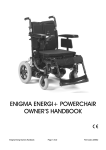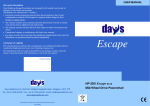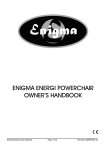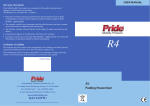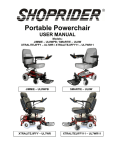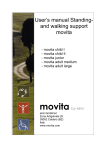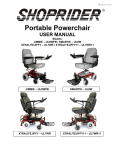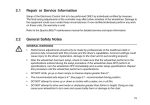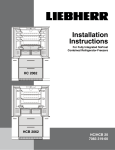Download Blitz User Guide 0305
Transcript
3 Some Useful Tips Before you venture off on your first journey, ensure that everything is adjusted to your specific needs, read this manual to familiarise yourself with the product and its functions. DO NOT attempt to drive without an attendant on hand until you are fully proficient in using and manoeuvring your powerchair. Ensure power is switched off before entering or leaving your powerchair. Before switching on, check that both motors are engaged, tyres are inflated to the correct pressure and are in good condition. When on the move DO NOT attempt turns at full speed, especially while travelling downhill. Before changing from forward to reverse, and vice versa, you must stop, failure to do so will cause severe damage to the electronics. DO NOT use your powerchair beyond it’s limitations. Due to both the weight of a powered wheelchair and it’s occupant it is not advisable to attempt to be assisted up and down stairs whilst seated. When entering or leaving your powerchair, DO NOT stand on the footplates. If you have to brake in an emergency, release the joystick. DO NOT switch off power while the powerchair is moving, it would cause an abrupt, sharp stop. DO NOT use your powerchair beyond the limitations set out in this manual concerning kerb height, gradients, etc. Stability and Balance To ensure stability and safe control of your powerchair you must at all times maintain proper balance. The powerchair is designed to remain stable and 23 upright during normal use, so long as you do not move your centre of gravity outside the normal seating position. REACHING - BENDING FORWARD • Ensure power is OFF. DO NOT lean your body forward out of the powerchair further than the length of the armrests. • DO NOT attempt to pick up objects from the floor by bending forward and reaching between your knees. • DO NOT attempt to reach objects by sliding forward to the edge of the Powerchair seat. REACHING - BENDING BACKWARDS 24 • Again ensure power is switched OFF. • DO NOT reach back any further than your arm will extend without changing your sitting position. • DO NOT lean over the top of the backrest as it will shift the centre of gravity, risking tipping over. • DO NOT hang heavy loads or objects on the backrest. They may make the powerchair unstable, especially on an incline. TRANSFERRING TO AND FROM OTHER SEATS • ALWAYS turn the wheelchair power OFF and engage the motor locks/clutches to prevent the wheels from moving BEFORE attempting to transfer in or out of the wheelchair. Also, make sure every precaution is taken to reduce the gap distance by turning both rear castors away from the object you are transferring onto. • When transferring, position yourself as far back as possible in the seat. This will prevent broken screws, damaged upholstery and the possibility of the wheelchair tipping forward. • Note: This activity may be performed independently provided you have adequate mobility and upper body strength. • Position the wheelchair as close as possible along side the seat to which you are transferring, with the rear wheels pointing away from it. • Engage motor locks/clutches. • Shift body weight into seat with transfer. • During independent transfer, little or no seat platform will be beneath you. Use transfer board if at all possible. 25 NEGOTIATING GRADIENTS/SLOPES • Never attempt to climb or descend an incline where the surface is rough, wet or slippery (gravel, loose chippings, grass, rain, black ice, snow etc.). • If you are in a situation where by the Powerchair fails to climb a ramp and stalls midway through the manoeuvre, DO NOT attempt to turn the Powerchair to drive back down in a forward facing direction, always reverse slowly in a steady, flowing action and DO NOT brake harshly, as this will upset balance in this situation. If possible, always seek the assistance of an attendant. NEGOTIATING KERBS 26 • When approaching kerbs wherever possible mount and dismount pavements via ramps. Always approach the kerb head on, not at an angle. • When approaching a kerb stop approximately 5cm from the kerb edge, then push the joystick firmly forward and continue to climb over the obstacle in one movement. DO NOT pause or attempt to steer during this movement. • NOTE: Take care when mounting or dismounting a kerb as it may be possible to lose drive if the antitipping castors contact the ground 3 2 Direction of Travel YOU, YOUR POWERCHAIR AND OTHERS • Powerchairs are strictly forbidden on motorways and their use is strongly discouraged on highways with fast moving traffic. • On the Pavement, in Pedestrian Zones or in Supermarkets it is obvious that you must show as much consideration and common sense to others as you expect from them. • When you cross the carriageway of a public road take extra care and allow time to cross, observe the Highway code. Although you are not required by law to hold a driving license, you are responsible and fully liable for proper operation. An important fact to bear in mind is that you must not present a traffic hazard even in the event of a breakdown. The most common cause may be discharged batteries. It is important to keep the batteries in a fully charged condition, we can only repeat this warning at this stage. If you do suffer a breakdown for whatever reason, you should immediately: seek the assistance of a passer-by. Explain where to find the motor disengagement/declutching lever, ask him/her to switch to freewheel, so that the Powerchair can be pushed by hand and moved. When in a safe place always ensure motor gear boxes are re-engaged. SAFEGUARDING OTHERS • We want you to get the most out of your INVACARE Powerchair, ensuring that the safety of yourself and others is never in jeopardy. If you are in any doubt about safe techniques, handling or care of the Powerchair, contact a recognised expert before putting yourself and others at risk. 27





